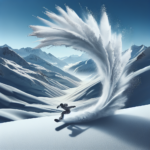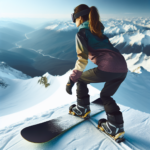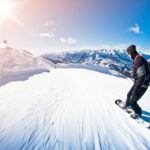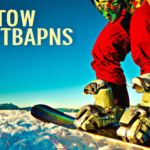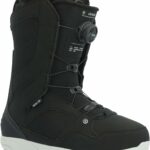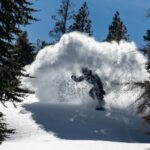Get ready to rule the slopes with style and speed! If you have ever found yourself veering off course while snowboarding or struggling to maintain a straight line, this article is just what you need. Packed with expert advice, we’ll guide you through an easy-to-follow routine aimed at helping you master the art of going straight on a snowboard. It’s time to take control, embrace the exhilaration, and enjoy a smoother, more satisfying ride down your favorite snowy mountainside. So gear up, because by the time you’re finished with this article, you’ll be eager to put your newfound skills to the test!
Understanding Snowboarding Basics
Snowboarding, like any other sport, has its foundational techniques. Becoming proficient at snowboarding involves understanding these basics that would eventually form the base of your skill set as you get better. So let’s get started!
Understanding the equipment and its roles
Before you start snowboarding, it’s essential for you to familiarize yourself with the equipment and their respective roles. The snowboard is a flat board that allows you to glide on snow. It’s wider compared to a ski, and you stand on it sideways. Bindings are attached to the snowboard to secure your boots. Your snowboard boots should be comfortable and snug, providing ankle support and warmth. Helmets and goggles are also key equipment pieces, providing safety and vision clarity.
Understanding body positioning on a snowboard
When you’re on a snowboard, proper body positioning is critical. Maintain a slight bend in your knees and hips while keeping your torso upright and aligned with the middle of the board. Your arms should be relaxed, and your head should be facing the direction in which you intend to go. It’s also important to keep your weight centered over your board to efficiently control it.
Understanding the concept of balance on a snowboard
Snowboarding requires excellent balance. It’s about more than just not falling over; effective balance allows for smooth movement and execution of tricks down the line. Without efficient balance, you’ll find it hard to control the board. So concentrate on keeping your body weight centered over your feet while moving, this will help ensure that you can control your snowboard effectively.
Practicing Basic Stances
Having started understanding the snowboarding basics, the next big step is to get comfortable with a few basic stances. These stances form the foundation upon which many snowboarding techniques are built.
Practicing the athletic stance
Now you might wonder, what’s ‘the athletic stance’? Well, you start with your feet shoulder-width apart, your knees and hips slightly bent and your torso upright. This posture resembles the stance you’d take when playing most sports and helps you respond quickly and effectively to changes in terrain or direction while snowboarding.
Practicing the snowboarding stance
The snowboarding stance refers to how you position your body while being on the snowboard. Stand with your feet spread to about the width of your shoulders. Your leading foot will be strapped into the bindings while the back foot will be free at first.
Mastering the forward stance
Mastering the forward stance is all about having your torso and hips aligned with the snowboard’s direction of movement. This is crucial as it lets you see clearly in the direction you are heading while snowboarding. Remember not to lean too far forward or backward as it can throw off your balance.
Learning to Glide on a Snowboard
Gliding smoothly and confidently on a snowboard is an early step towards mastering the sport. This is where you’ll start to feel the thrill of snowboarding as you slide down the slopes.
Starting with a single-footed glide
The single-footed glide is an excellent way for beginners to get comfortable with the feeling of moving on a snowboard. Start by placing one foot in the front binding (usually your left foot if you’re right-handed, or vice versa) and use the free foot to push off.
Transitioning to a two-footed glide
Once you’re confident with the single-footed glide, you can move on to the two-footed glide. Here, you need to strap both feet into the bindings and practice gliding down a gentle slope. Remember to maintain your balance and keep your knees slightly bent.
Mastering straight gliding on a snowboard
Straight gliding involves moving down a hill without turning. This helps you get accustomed to the feeling of speed and understand how you balance at higher speeds. Just make sure the slope isn’t too steep when you’re starting with this.
Mastering Edge Control
If you want to know how to go straight on a snowboard, mastering edge control is paramount. It comes into play when making turns, stopping, and controlling speed.
Understanding edge control and its importance
Edge control refers to how you use the edges of your snowboard to navigate, control your speed and make swift, decisive turns on the snow. Proper edge control helps prevent falls and ensures a safe and smooth ride down the slope.
Learning to use the heel and toe edges
Snowboards have two edges: the heel edge and the toe edge. Your heel edge is behind you, and your toe edge is in front. When you lean back onto your heels while keeping your toes up, you’re using your heel edge. When you lean forward on your toes while lifting your heels, you’re using your toe edge.
Practicing edge transitions
Edge transitions refer to the ability to switch your weight from your toe edge to your heel edge (and vice versa) while snowboarding. Make sure to do this smoothly, without suddenly shifting your weight, to maintain balance and control over the board.
Controlling Speed and Direction
After mastering edge control, the next step is to learn how to control your speed and navigate your snowboard’s direction. Let’s look into these aspects more closely.
Learning to slow down and stop
The most common method to slow down or stop is to use a technique called “skidding”. This is where you apply pressure to your board’s edges to create friction against the snow.
Understanding how to steer your snowboard
Routing your snowboard involves shifting your weight and using your edges. To turn left, apply pressure to your heel edge (for regular riders) or toe edge (for goofy riders), and vice versa for turning right.
Practicing speed control maneuvers
Once you’ve learned to slow down, stop, and steer your board, it’s important to practice controlling your speed using these maneuvers, especially on steeper slopes or in crowded areas.
Familiarizing Yourself with Different Snow Conditions
Different snow conditions can have a significant impact on how your snowboard behaves. It’s critical to adjust your strategy accordingly to stay safe and improve your overall performance.
Educating yourself about different types of snow
There’s a wide variety of snow types, from light and powdery snow to wet, heavy snow. The type of snow can significantly affect the speed and control of your snowboard. Stay observant and educate yourself about the various snow conditions.
Adapting to changing snow conditions
Learn to adapt your snowboarding techniques for different snow conditions. For example, you might have to lean back more in deep, powdery snow to prevent your board’s nose from sinking.
Understanding how snow conditions impact your snowboarding
Remember, different snow conditions can drastically affect your snowboard’s speed, your ability to turn smoothly, and even the efficacy of your brakes. Thus, understanding the relationship between snow conditions and your snowboarding techniques is critical.
Working on Your Balance and Coordination
One of the fundamental aspects of snowboarding is good balance and coordination. Improving on these can greatly enhance your snowboarding experience.
Doing balance and coordination exercises
Off-board exercises such as yoga, slacklining, or even standing on one leg can significantly improve your balance and coordination for snowboarding.
Learning why balance and coordination are crucial for snowboarding
Sound balance and coordination allow you to make smooth and controlled turns, maintain a steady speed, and recover quickly if you start to fall. They are an integral part of almost every snowboarding technique.
Implementing balance and coordination while snowboarding
Once you’ve done the exercises and understood their importance, it’s time to put them into practice. Stay aware of your body, maintain control over your movements, and implement your improved balance and coordination while on the snowboard.
Developing a Linking Turns Pattern
The next step to mastering straight snowboarding is learning to link turns smoothly and consistently.
What is a linking turns pattern?
A linking turns pattern means smoothly moving from one turn into another, switching from one edge of your snowboard to the other. It forms the core of most snowboarding techniques.
Why you need to develop a linking turns pattern
Linking turns effectively helps you maintain a steady rhythm and control your speed while snowboarding. It’s crucial for navigating varied terrain and making your ride smoother.
How to practice linking turns on a snowboard
Start at the top of a gentle slope, start with one turn, stabilize yourself in the straight path, and then initiate another. The key to linking turns smoothly is moving your weight gradually from edge to edge while maintaining your balance.
Tips for Keeping Safe While Snowboarding
Now, while you’re out there having fun, safety should always be a top priority. It’s crucial to understand the potential risks and what you can do to mitigate them.
The importance of wearing protective gear
Always prioritize safety equipment, including a well-fitted helmet, goggles, wrist guards, and padding. These pieces can protect you from potential injuries and add a layer of safety as you learn and explore new skills.
Knowing the safety rules and guidelines
Snowboarding, like any sport, has certain rules and guidelines that ensure everyone has a safe and enjoyable time on the slopes. Ensure you’re familiar with these before heading out.
Understanding the dangers of reckless snowboarding
While it may be tempting to take on more than you’re ready for, reckless snowboarding can lead to serious injuries. Know your limits, and gradually build up your skills.
Conclusion: The Path to Mastering Straight Snowboarding
Snowboarding is a challenging yet rewarding sport. It requires patience, regular practice, and dedication to improve.
Maintaining patience during the learning process
Sure, you’ll fall and make mistakes along the way, but that’s a part of the learning process. Dust yourself off, learn from your errors, and keep practising. With patience and perseverance, you’ll be mastering the slopes in no time.
The importance of regular practice
Snowboarding is a sport that highly rewards regular practice. The more time you invest in learning and refining your techniques, the faster you’ll improve. So keep at it!
Respecting the sport and the environment
Lastly, it’s important to respect others on the slope and take care of the environment. Acting responsibly ensures a positive experience for everyone.
That’s it! Remember, the joy in snowboarding comes not just from mastery, but also from the process of learning and improving. Enjoy the journey, have fun, and stay safe out there!
- What Snowboard Bindings Should I Get? - January 23, 2024
- What Size Screws For Snowboard Bindings? - January 23, 2024
- How To Snowmobile On Water? - January 23, 2024

